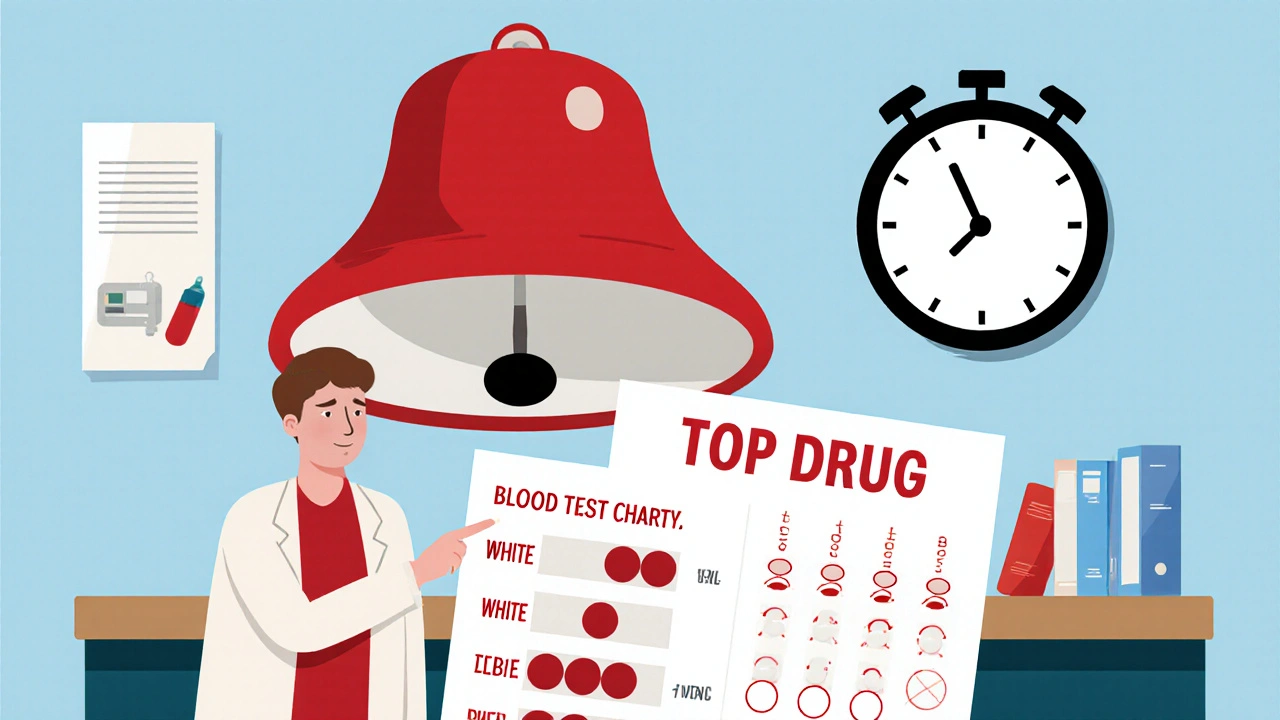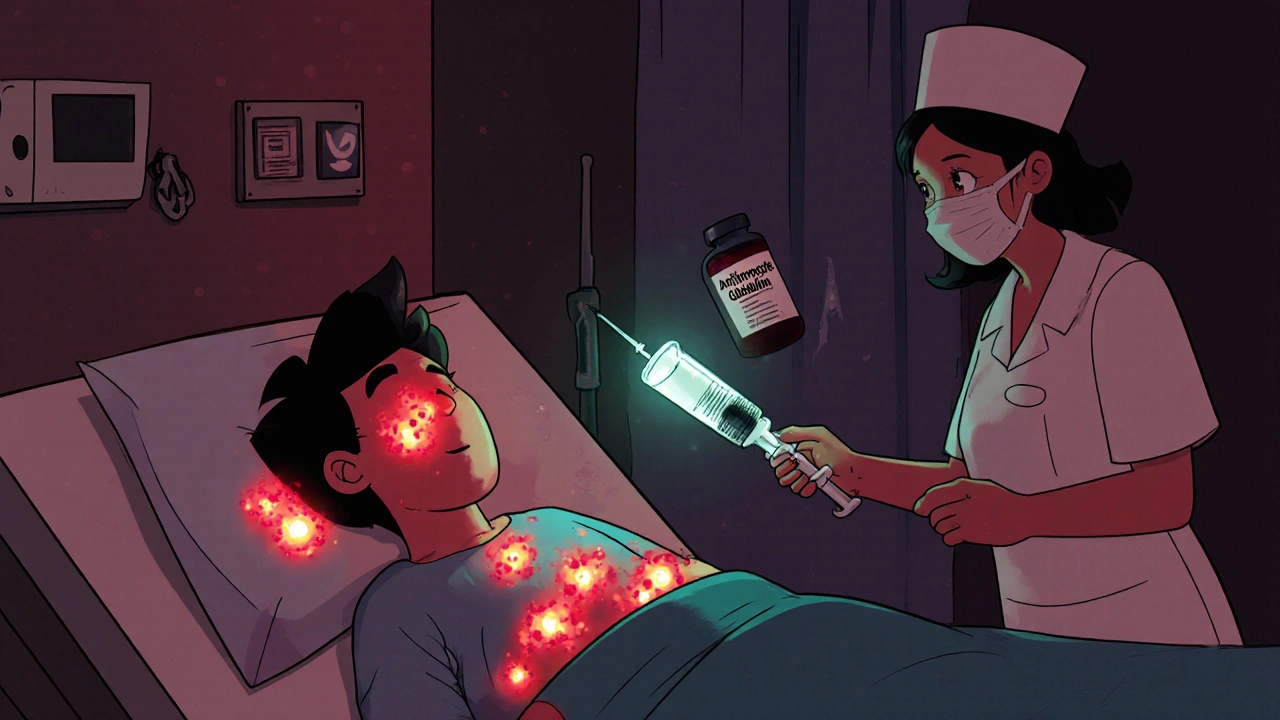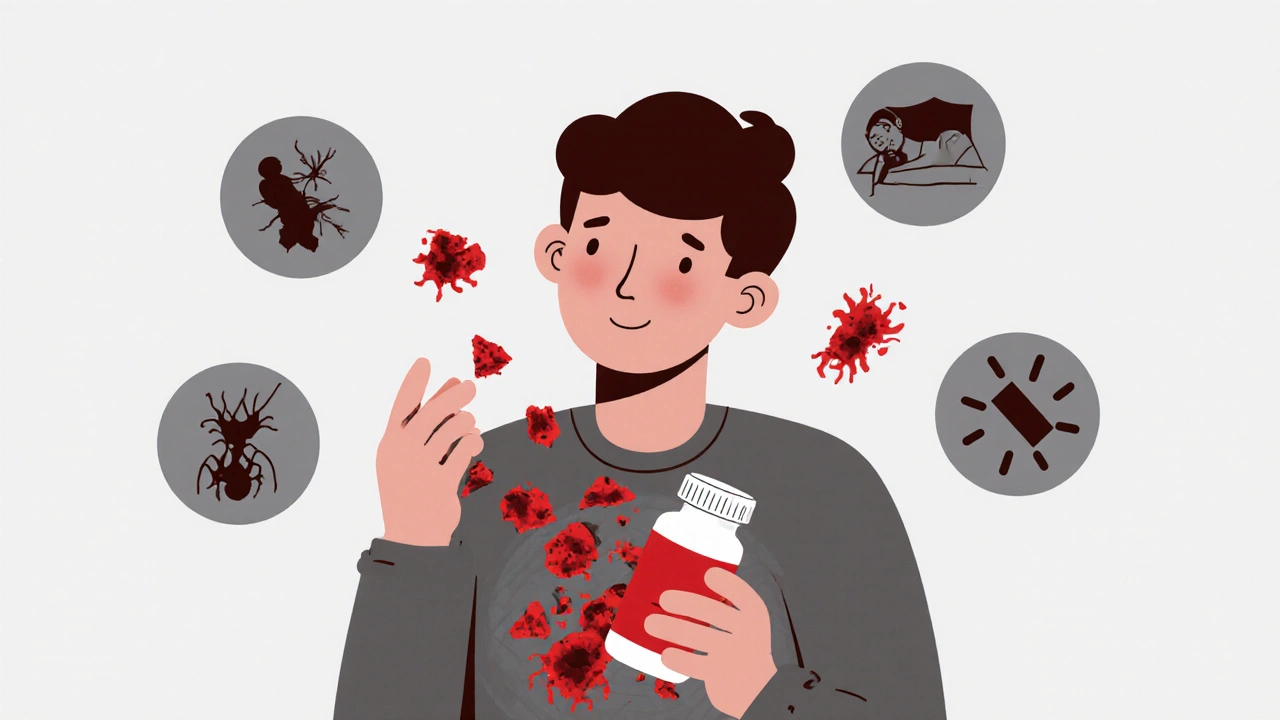Medication Risk Checker
Check Your Risk
This tool helps identify potential medication-induced aplastic anemia based on your current medications and symptoms. Remember: Early detection is critical for survival.
Your Risk Assessment
When you take a new medication, you expect side effects like a headache or upset stomach-not a life-threatening collapse of your blood production. But for some people, common drugs can silently shut down the bone marrow’s ability to make red blood cells, white blood cells, and platelets. This is medication-induced aplastic anemia, a rare but deadly condition that strikes fast and often goes unnoticed until it’s too late.
What Exactly Is Medication-Induced Aplastic Anemia?
Aplastic anemia isn’t just low blood counts-it’s when your bone marrow stops working. Normally, your bone marrow churns out hundreds of billions of blood cells every day. In aplastic anemia, that factory shuts down. The result? Not one, but all three types of blood cells drop dangerously low: hemoglobin (red cells), neutrophils (infection fighters), and platelets (clot makers). This is called pancytopenia.
Medications cause this by either directly poisoning stem cells or triggering your immune system to attack them. It’s not the same as chemo-induced low counts, which usually bounce back. True medication-induced aplastic anemia means your marrow stays empty-even after you stop the drug. About 5-10% of all acquired cases come from drugs, and it’s one of the few forms you can actually prevent.
Which Medications Are Most Dangerous?
Not all drugs carry this risk. But a handful have been linked to aplastic anemia for decades-and still show up in prescriptions today.
- Chloramphenicol: An old antibiotic, rarely used now, but still prescribed in some countries. It increases risk by 30-60 times. One in every 24,000-40,000 users develops it.
- Carbamazepine and phenytoin: Common seizure meds. Carbamazepine raises risk 15-fold. The European Medicines Agency now requires stronger warnings on its label.
- Sulfonamides and penicillin derivatives: Antibiotics many people take without thinking. Even a short course can trigger immune attacks on bone marrow.
- Gold compounds: Used for rheumatoid arthritis. Still in use, but mostly replaced by newer drugs.
- NSAIDs: Like phenylbutazone (banned in many countries) and high-dose, long-term use of others.
- Certain antipsychotics: Especially clozapine, which requires monthly blood monitoring for this very reason.
What’s scary is that you might not know you’re on a risky drug. Some of these are generics, old, or prescribed for off-label uses. If you’ve been on any of these for more than a few weeks and feel off, don’t assume it’s just stress.
Early Signs No One Talks About
Most people think of aplastic anemia as sudden, dramatic bleeding or infections. But the real danger is the quiet phase-weeks before you feel really sick.
Here’s what to watch for:
- Unexplained fatigue: Not just tired after work. Constant exhaustion that sleep doesn’t fix.
- Easy bruising: Purple spots on your arms or legs with no bump or fall. Multiple bruises appearing at once? That’s a red flag.
- Recurrent low-grade fevers: 99-101°F for days, with no cough or sore throat. Your body is fighting hidden infections because your white cells are gone.
- Unintentional weight loss: Losing 5-10 pounds over 2-3 weeks without trying.
- Prolonged recovery from minor infections: A cold that lasts 3 weeks. A cut that won’t stop oozing. A yeast infection that won’t clear.
These symptoms often get misdiagnosed as the flu, stress, or depression. In fact, 72% of patients in one survey were told they had a virus before the real cause was found. The problem? Blood tests aren’t always ordered early. And when they are, doctors might miss the pattern.

Why Timing Is Everything
Delaying action changes everything. Dr. Neal Young from the NIH found that if you catch medication-induced aplastic anemia within two weeks of symptoms starting, your survival rate is under 10%. Wait eight weeks, and it jumps to 45%.
Why? Because your body is running out of backup. Platelets below 20,000 mean spontaneous bleeding. Neutrophils below 500 mean you can’t fight off a simple cold. Once you hit those numbers, you’re in the ICU.
One patient from Boston, who took carbamazepine for nerve pain, noticed fatigue and a few bruises. Her doctor said it was “just aging.” Three weeks later, she collapsed from internal bleeding. Her platelets were at 8,000. She needed a bone marrow transplant. She survived-but barely.
What to Do Right Now If You Suspect It
If you’re on one of the high-risk meds and have two or more of the early signs, here’s your action plan:
- Stop the drug immediately. Do not wait for a doctor’s appointment. Call your prescriber, but don’t delay. Eighty-five percent of mild cases improve within four weeks of stopping the drug.
- Get a CBC (complete blood count) within 24 hours. This isn’t optional. Ask for the actual numbers: hemoglobin, absolute neutrophil count, platelet count. Don’t just accept “everything’s normal.”
- If platelets are below 50,000 or neutrophils below 1,500, see a hematologist today. Don’t wait for a referral. Go to urgent care or the ER if needed.
- If you have a fever above 100.4°F and low blood counts, go to the ER now. This is a medical emergency. You need antibiotics within an hour.
- Bring your full medication list. Include supplements, over-the-counter drugs, and herbal products. Many cases are triggered by combinations, not single drugs.
Don’t wait for a biopsy. The CBC comes first. If it shows pancytopenia, a bone marrow biopsy confirms the diagnosis. But stopping the drug and getting support can save your life before that.
How to Protect Yourself Before Starting a New Drug
Prevention beats crisis. If you’re about to start a high-risk medication:
- Ask your doctor: “Is this linked to bone marrow suppression?”
- Request a baseline CBC before you start.
- Ask for weekly CBCs for the first 4 weeks. Many clinics don’t do this-but they should.
- Use a pill tracker app. The AAMDS Foundation has a free one that alerts you to warning signs.
- Keep a printed list of all your meds. Emergency rooms don’t always have time to dig through your portal.
Studies show patients who get this education are 3.5 times more likely to catch problems early. In rural areas, where labs are far away, this makes all the difference.

What Happens After Diagnosis?
If it’s confirmed, treatment depends on severity. Mild cases often recover on their own after stopping the drug. Severe cases need immunosuppressive therapy-drugs like horse antithymocyte globulin and cyclosporine. These quiet the immune system so your marrow can heal. About 78% of patients respond well.
If that doesn’t work, a bone marrow transplant is the only cure. But even then, survival rates are now over 85% if caught early. That’s better than many cancers.
And here’s the hard truth: Never restart the drug that caused it. The risk of relapse is 90%. Even if you feel fine, your marrow is still vulnerable.
Why This Is Still Underdiagnosed
Only 28% of cases are correctly identified the first time someone walks into a clinic. Why?
- Doctors don’t think of it-it’s rare.
- Patients don’t connect fatigue to meds.
- Lab results are misinterpreted.
- Electronic alerts in medical systems are often turned off or missing.
One study found that hospitals with automated alerts for high-risk drugs reduced diagnostic delays by over 11 days. That’s weeks of life saved.
But you don’t have to wait for the system to fix itself. You can act now.
Can you get aplastic anemia from over-the-counter drugs?
Yes. While most cases come from prescription drugs, high-dose or long-term use of NSAIDs like phenylbutazone (still available in some forms) and even certain herbal supplements have been linked. Always assume any drug that affects your immune system or liver could carry this risk.
How long does it take for symptoms to appear after taking the drug?
It varies. Some people see changes in blood counts within 1-3 weeks. Others don’t show symptoms until 6-8 weeks. The median time is 4-6 weeks. That’s why weekly blood tests during the first month on high-risk drugs are critical.
Is aplastic anemia the same as leukemia?
No. Aplastic anemia means your bone marrow is empty. Leukemia means it’s full of cancerous cells. They’re opposites. But in rare cases, aplastic anemia can turn into MDS (myelodysplastic syndrome), which can progress to leukemia. That’s why long-term monitoring is essential.
Can children get medication-induced aplastic anemia?
Yes. Children are more vulnerable because their bone marrow is still developing. Cases have been reported from antibiotics, antiseizure drugs, and even some acne medications. Pediatricians often miss it because symptoms look like common childhood illnesses. If your child has unexplained fatigue, bruising, or fevers lasting more than two weeks, demand a CBC.
What if I’ve already stopped the drug but still feel awful?
Stopping the drug is step one, but recovery takes time. If you’re still tired, bruising easily, or getting infections, you may still have low blood counts. Don’t assume it’s “just taking a while.” Get a repeat CBC. If counts haven’t improved in 4 weeks, you need a hematologist. Recovery isn’t guaranteed-it depends on how much damage was done.
Final Takeaway: Your Life Could Depend on This
Medication-induced aplastic anemia is rare-but it’s not random. It’s predictable. It’s preventable. And it’s silent until it’s too late.
If you’re on a high-risk drug, know the signs. If you’re feeling off, don’t wait. Get your blood tested. Keep a list of your meds. Speak up. Your bone marrow can’t tell you it’s failing. But you can. And if you do, you might just save your life.


Just had my third CBC in six weeks because I’ve been on carbamazepine for trigeminal neuralgia - and honestly, I’m glad I pushed for it. My platelets were at 48k. My doctor said ‘it’s probably fine,’ but I’ve read enough to know that ‘fine’ doesn’t mean ‘safe.’ Stopped the med immediately. Hemoglobin’s climbing back. Don’t wait for bleeding. Get the numbers.
Bro, this hits different. I’m from Delhi and saw a guy in the chai stall last week - young dude, 28, looked like he’d been run over by a truck. Turns out he was on generic penicillin for acne and ended up in AIIMS with aplastic anemia. Docs didn’t even ask about meds. Just gave him iron pills. 😔
India’s got a million generic pharmacies. No one checks. No one warns. This needs to be on every pharmacy counter. Like, printed on the blister pack. Not just in some NIH paper.
Of course Americans don’t know this - you all take antibiotics like candy and think ‘natural remedies’ fix everything. Meanwhile, in Europe, they’ve banned half these drugs since the 80s. We don’t need your ‘personal responsibility’ when your healthcare system is a dumpster fire.
My cousin’s a hematologist in Chicago. She says the real tragedy isn’t the disease - it’s that 90% of patients are told they’re ‘anemic’ and sent home with iron. No one looks at the neutrophils. No one checks the platelets. It’s all about the hemoglobin. And that’s why people die.
life is a gamble but some gambles are written in your prescription bottle 🤕
stop ignoring the whispers your body gives you. fatigue isn’t laziness. bruises aren’t bad luck. fevers without a cold? that’s your marrow screaming. listen. please.
How quaint. A 12-page treatise on a condition that affects roughly 2-3 people per million annually. How noble of you to treat this as if it’s a pandemic when it’s statistically closer to being struck by lightning while being bitten by a shark. The real public health crisis is the over-medicalization of fatigue. Perhaps we should all just go outside and stop taking pills?
Just shared this with my mum - she’s 71 and on sulfamethoxazole for a UTI. She’s been ‘tired’ for weeks. I made her book a CBC for tomorrow. Thank you for writing this. Seriously. I think you just saved her life.
As a Nigerian-American, I’ve seen how medication safety is treated differently across borders. In Lagos, pharmacists hand out antibiotics like candy - no prescription, no follow-up. In the U.S., we over-test and under-educate. This post bridges both worlds. We need global awareness - not just American-centric alerts.
man i was on phenytoin for 6 months after my seizure and never got tested. i thought i was just ‘stressed’. now i’m scared. thanks for the wake-up call. gonna call my doc tomorrow. 🙏
Let me get this straight - you’re blaming Big Pharma and lazy doctors for a condition that’s RARE? Meanwhile, people are dying from opioid overdoses, diabetes complications, and vaccine hesitancy - and you’re writing a novel about a 1-in-40,000 drug reaction? This is performative health anxiety at its finest.
My dad had this after taking gold salts for RA in the 90s. He recovered after a transplant - but his immune system’s been broken since. He’s 72 now. I still check his CBCs every 6 months. It’s not ‘rare’ if it ruins your life.
One thing missing: what about herbal supplements? I’ve seen cases triggered by high-dose green tea extract, kava, and even black cohosh. They’re not regulated, so no one tracks them - but they can be just as dangerous. Always mention them to your doctor.
Pharmacovigilance is a hermeneutic failure of the biomedical paradigm - the reductionist model of drug toxicity fails to account for epigenetic susceptibility gradients in polypharmacy cohorts. The bone marrow, as a hematopoietic niche, is not merely a passive target but an active sensor of xenobiotic-induced homeostatic collapse. We must reframe this as a systems biology emergency, not a pharmacological footnote.
As someone who works in clinical research, I’ve reviewed dozens of cases like this. The real issue isn’t just the drugs - it’s the delay in diagnosis. One study showed that when primary care providers received automated alerts for high-risk meds combined with patient-reported fatigue, the time to CBC dropped from 21 days to 3.5 days. That’s life-saving. But most EHRs still don’t do this. Hospitals are stuck in the 2000s. We need mandatory electronic flags for carbamazepine, clozapine, sulfonamides - and they need to be loud, unignorable, and tied to automatic lab orders. This isn’t just good practice - it’s ethical. And until the system changes, patients like you - the ones who read, question, and demand tests - are the only safety net we’ve got.